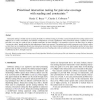Free Online Productivity Tools
i2Speak
i2Symbol
i2OCR
iTex2Img
iWeb2Print
iWeb2Shot
i2Type
iPdf2Split
iPdf2Merge
i2Bopomofo
i2Arabic
i2Style
i2Image
i2PDF
iLatex2Rtf
Sci2ools
INFSOF
2006
2006
Prioritized interaction testing for pair-wise coverage with seeding and constraints
Interaction testing is widely used in screening for faults. In software testing, it provides a natural mechanism for testing systems to be deployed on a variety of hardware and software configurations. In many applications where interaction testing is needed, the entire test suite is not run as a result of time or budget constraints. In these situations, it is essential to prioritize the tests. Here, we adapt a ``one-test-at-a-time'' greedy method to take importance of pairs into account. The method can be used to generate a set of tests in order, so that when run to completion all pair-wise interactions are tested, but when terminated after any intermediate number of tests, those deemed most important are tested. In addition, practical concerns of seeding and avoids are addressed. Computational results are reported.
| Added | 13 Dec 2010 |
| Updated | 13 Dec 2010 |
| Type | Journal |
| Year | 2006 |
| Where | INFSOF |
| Authors | Renée C. Bryce, Charles J. Colbourn |
Comments (0)

